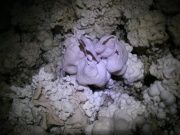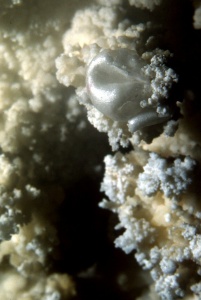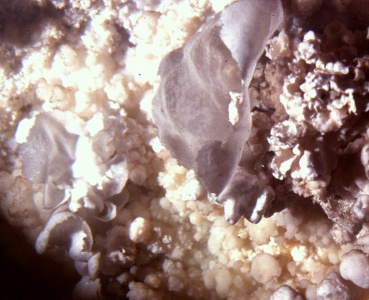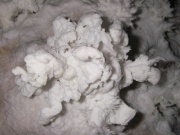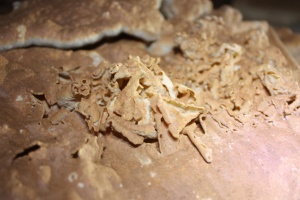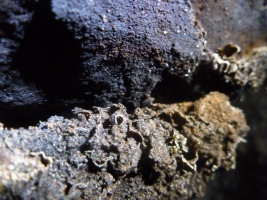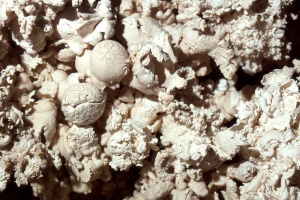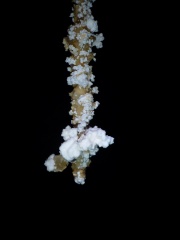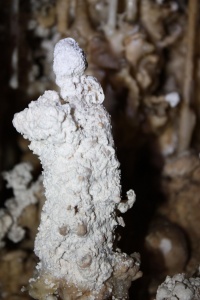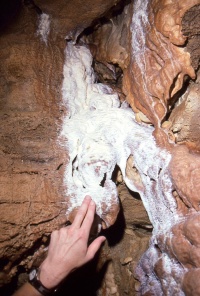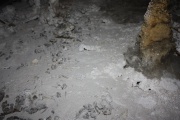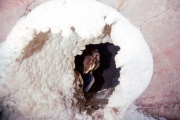Hydromagnesite (Inventory)
From LagWiki
Contents |
Balloon
The Balloon field of the Hydromagnesite section should be used to list stations that have a Hydromagnesite Balloon.
Hydromagnesite Balloons are thin hollow shells of hydromagnesite. They often look like they have been inflated and then maybe partially deflated. They are usually white in color and may have a pearly texture. They are mainly found on bedrock but sometimes on other speleothems. They are also most commonly found on the cave walls. Balloons are rare and there are no known situations where they are actively forming. If you happen to find one which appears to be forming (it may appear to be wet and pliable), that would be a good time for a note on the inventory form and a photograph.
References
- Palmer, Arthur N. (2007) Cave Geology CAVE BOOKS, Dayton, OH pp 292-293 ISBN-13: 978-0-939748-66-2, ISBN-10: 0-939748-66-5
- unknown (1997) Geology of Carlsbad Caverns Class - 1997 Memorial Day Expedition p 4
Balloon, Hydromagnesite
Crinkle Blister
The Crinkle Blister field of the Hydromagnesite section should be used to record stations which exhibit cave blisters.
Crinkle Blisters are thin, hollow balls that form on cave walls and other speleothems. Even though this field appears under the hydromagnesite section of the CCNP Cave Inventory Form, most blisters are made of calcite or gypsum. Any blisters found should be recorded here no matter their composition which may be difficult to determine, anyway. Most crinkle blisters are rarely more than a few centimeters in diameter. They can sometimes appear as curling flakes. The thickness of the walls can range from half a millimeter to almost one centimeter. They are formed from pasty minerals which have dried. They sometimes appear in blobs like shaving cream.
References
- Palmer, Arthur N. (2007) Cave Geology CAVE BOOKS, Dayton, OH p 293 ISBN-13: 978-0-939748-66-2, ISBN-10: 0-939748-66-5
Crinkle Blister, Hydromagnesite
Moonmilk
The Moonmilk field of the Hydromagnesite section should be used to record any observation of moonmilk no matter its mineral content which may be hard to determine in the field anyway.
Moonmilk is a soft, white, pasty deposit. The texture is often described as having the consistency of cottage cheese. Small particles in the deposit account for the smooth texture. It can range from liquid to a dry powder depending upon the environment. The powder form is inventoried in a different field.
The mineral content of moonmilk can be hydromagnesite, dolomite, huntite, calcite, aragonite, or a variety of other minerals. It is most commonly found near the intersection of the massive reef with either the forereef or backreef. Moonmilk deposits can appear anywhere and on anything including other formations.
See also
References
- Burgess, Harry. Canyons & Caves; Issue No. 3; Fall 1996; Moonmilk: http://www.nps.gov/cave/planyourvisit/upload/c&c3.pdf
Moonmilk, Hydromagnesite
Powder
The Powder field of the Hydromagnesite section should record any observation of the powdery form of moonmilk.
The powdery form of moonmilk can be any of a number of minerals including hydromagnesite, dolomite, huntite, calcite, aragonite, and others. The powdery form is usually white and looks like talcum powder. It is basically dehydrated moonmilk or corroded calcite. Any observation of powdery moonmilk should be recorded in this field as it is difficult to determine the specific mineral content without testing. The powdery form of moonmilk is usually found on the floor or shelves as it does not adhere well.
See also
References
- Palmer, Arthur N. (2007) Cave Geology CAVE BOOKS, Dayton, OH p 298 ISBN-13: 978-0-939748-66-2, ISBN-10: 0-939748-66-5
- Hill, Carol; Paolo Forti (1997) Cave Minerals of the World (Second Edition ed.) National Speleological Society p 143 ISBN: 1-879961-07-5
Rim
The Rim field of the Hydromagnesite section should be used to record stations that exhibit rims of hydromagnesite. Other mineral rims have their own field in their respective sections.
Hydromagnesite rims (also sometimes known as vents) are wind formed features of hydromagnesite. They form usually around constrictions where consistent airflow is present. Rims form as a shell or projection extending on the upwind side of a constriction where moisture laden air consistently escapes. As such, they tend to require a pool or water source somewhere on the downwind side in order to provide the moist, warm air.
Rims can be any of a number of shapes from round tubes or eggs to more irregular shells or ears. They tend to conform somewhat to the shape of the constriction but may be biased in only one direction by the airflow. They can be found on the floor, walls or ceiling; anywhere air is or was escaping.
Rims can form from various mineral materials and several of them have fields on the inventory form. The appropriate field based on the mineral content of the rim feature should be used. Only hydromagnesite rims are recorded in this field.
See also
